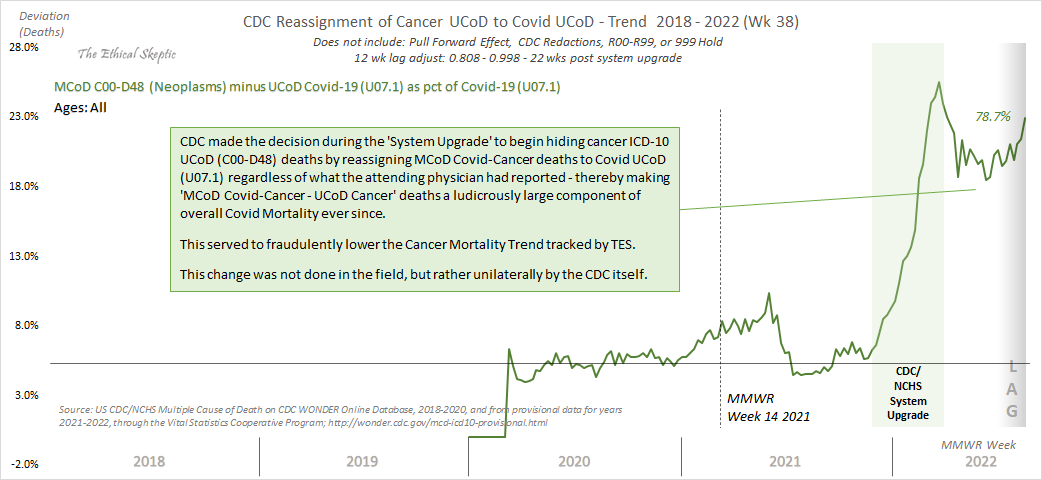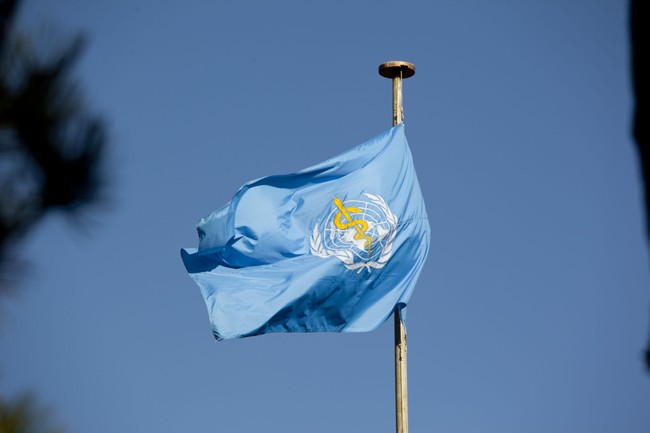You are using an out of date browser. It may not display this or other websites correctly.
You should upgrade or use an alternative browser.
You should upgrade or use an alternative browser.
CDC & WHO Malfeasance
- Thread starter GURPS
- Start date
‘Impeach him again’: CDC advisory committee plagued with political activism
The CDC's Advisory Committee on Immunization Practices (ACIP) is supposed to be a non-political body that evaluates and recommends vaccines for children and adults. Unfortunately, this outfit is not only plagued with corruption and special interests, it is also a hyper political entity, The Dossier has found.
ACIP is expected to meet Thursday to add Pfizer and Moderna’s COVID-19 injection to the list of required childhood vaccines without any clinical data supporting their position. This process would trigger blanket legal immunity for Pfizer and Moderna.
The Dossier has discovered that 6 ACIP committee members — Dr. Wilbur Chen, Dr. Helen Keipp Talbott, Dr. Nirav Shah, Dr. Camille Kotton, Dr. Grace Lee, and Lynn Bahta — maintain a public presence on Twitter.
Out of those 6, we discovered that four of the six regularly engage in political advocacy on the platform. Here’s but a small sample size of the political activism of committee members, which again, are tasked with the enormous responsibility of endorsing the safety and efficacy of children’s pharmaceutical products.
https://dossier.substack.com/p/the-...bstack&utm_campaign=post_embed&utm_medium=web
Dr Helen Keipp Talbott
Term: 10/29/2018 – 6/30/2023
Shares post comparing non-compliant Americans to 9/11 terrorists
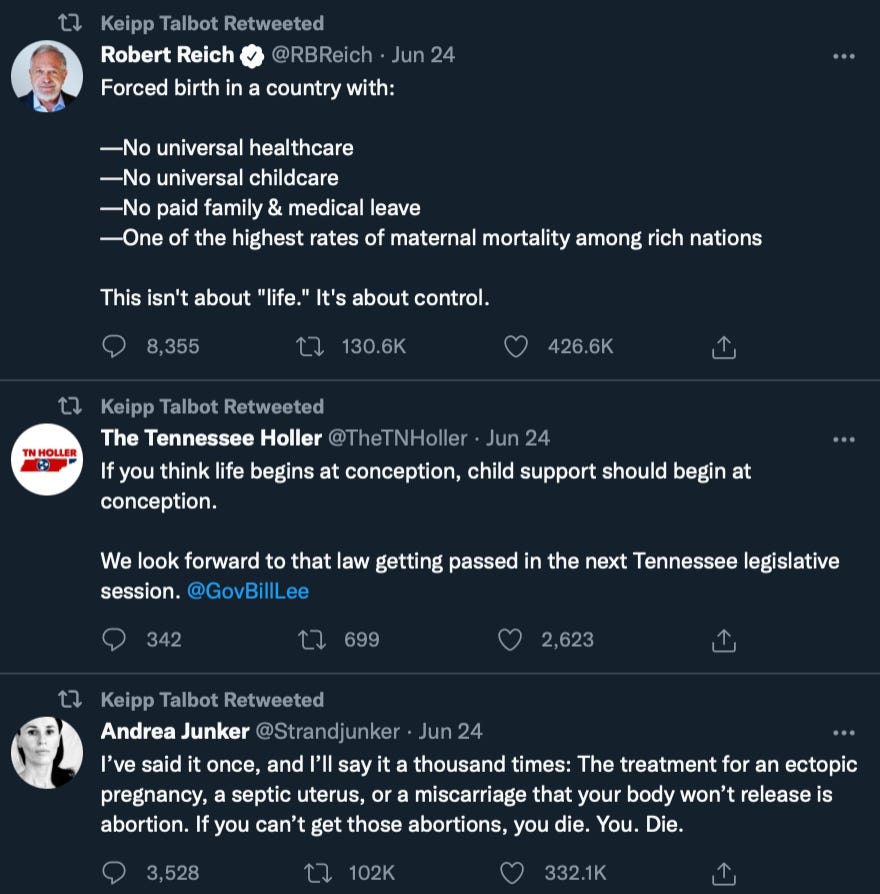
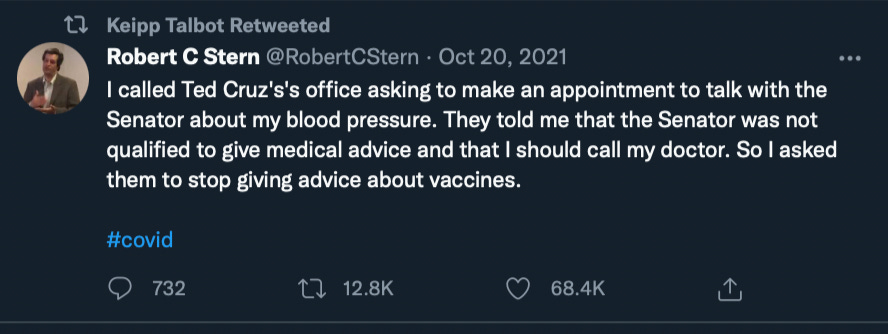
Dr Camille Nelson Kotton
Term: 12/23/2020 – 6/30/2024
Retweets attack on Florida Surgeon General Dr. Joseph Ladapo
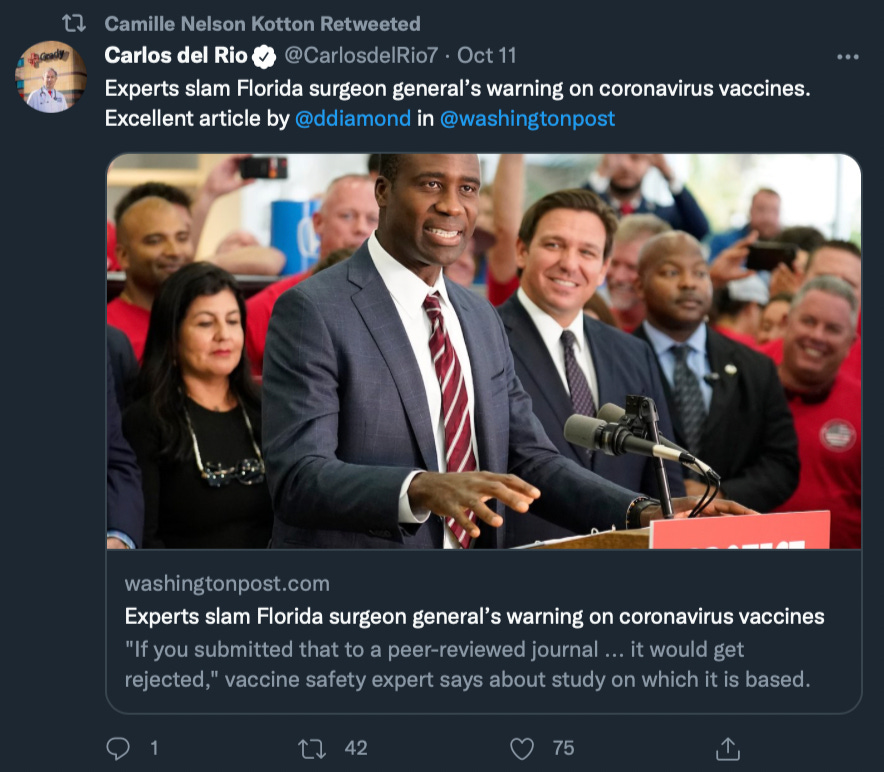
Retweets attack on Dr. Oz, candidate for senate in Pennsylvania

Retweets support for Hillary Clinton

Dr Grace Lee (Chair of CDC committee)
Term: 8/4/2021 – 6/30/2023
Retweets article on abortion advocacy

Retweets Dem congressman’s abortion advocacy
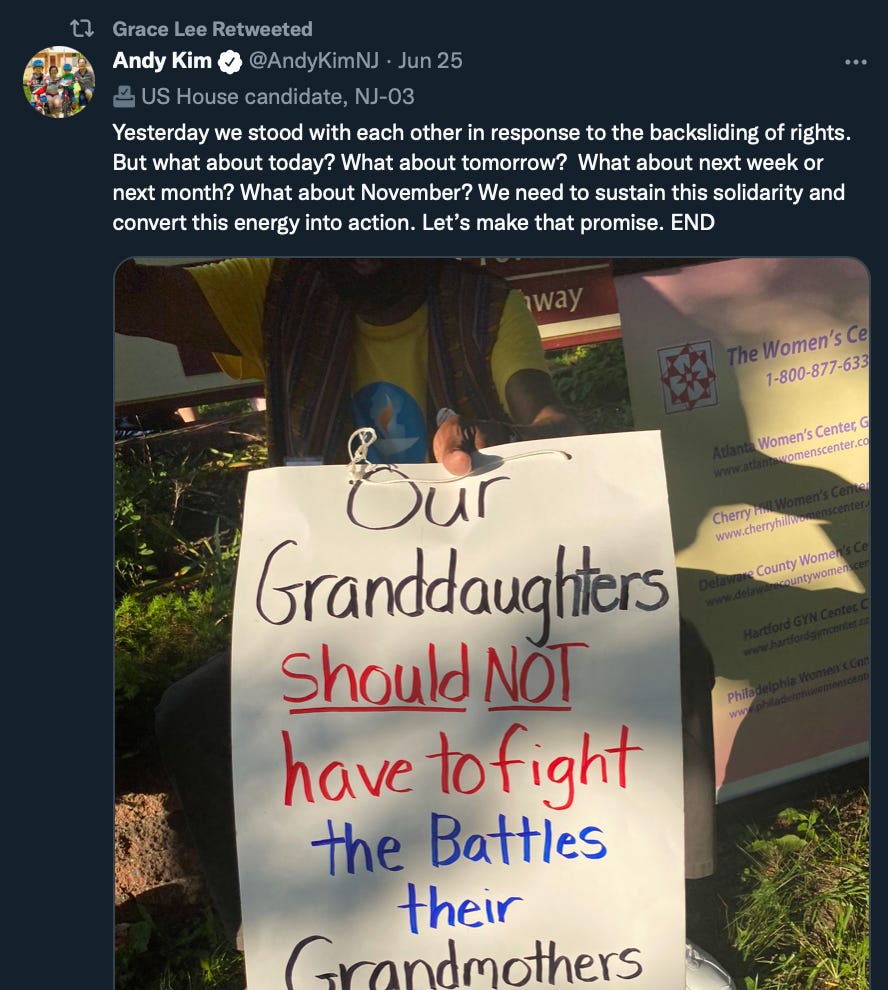
Two of the 15 committee members, who supposedly are experts or something, were wearing a mask ON ZOOM. They actually believe covid travels over the internet. Or maybe they think they can get it from THEMSELVES. Either way, it was a bad sign right from the jump.

The committee, who were all sitting in little boxes in a dystopian version of “Celebrity Jeopardy,” never discussed the fact that covid poses a miniscule risk to healthy kids. The committee never discussed natural immunity. The committee never discussed adverse events.
The CDC hasn’t yet officially added the shots to the standard school schedule, but given the unanimous recommendation from the committee, it’s a sure bet, likely to happen today or tomorrow.
As soon as that happens, the vaccine makers will permanently enjoy liability protection, and the national state of emergency that is currently shielding them can end. So that’s a blessing. Then it will be up to each state whether to follow the CDC’s new guidance and include the mRNA shots in its list of vaccines required to attend school. Many states allow religious exemptions, and a few states have recently eliminated exemptions.
There were a lot of reactions. Tucker interviewed Dr. Marty Makary about the vote, and the two discussed the lunatic absence of ANY clinical data supporting the ACIP’s decision.
Florida announced that nothing is going to change in the Sunshine State; covid will not be added to childhood vaccine schedules; and the state’s ban on covid vaccine mandates precludes requiring them anyway. So.
Arizona gubernatorial candidate Kari Lake promised that, if elected, she would make sure that the shots are not required for children in that state.
https://twitter.com/KariLake/status/1582816744363552768?s=20&t=IGdkpvP7fX4Xm3x1Q8WUQg
There’s a lot about this vote that is unique in American history. For one thing, it’ll be the first time a brand-new, unproven EUA drug will be mandated for kids. But in at least one sense, there’s nothing new about this.
For example, although Hepatitis B is almost always sexually transmitted, the CDC says it is necessary for infants. Infants! What does the CDC think is really going on in nursery school?
The CDC’s recommended schedule also includes a tetanus shot, even though tetanus is not infectious. The oral polio vaccine is actually a source of viral transmission, but it was still approved by the CDC for the school schedule. Neither measles nor mumps are fatal to children but those vaccines are also required to attend school.
For some reason.
Looking on the bright side, the silver lining is that the mask has been ripped off the CDC’s grotesque rubber-stamping process. Because of covid’s visibility and the intense interest around parent’s rights, quite a lot of people are paying attention, this time. This time, it’s not just a small group of kooky anti-vaccine activists bellyaching about autism or whatever. THIS TIME, a whole lot of folks are downright furious.
The decision was a done deal long before yesterday’s vote. The REAL battle will be at the state level. Except this time, the politically-devastating zeitgeist powering the pushback against vaccine mandates for adults is going to fuel parents’ war against jabs for their kids. This time, the resistance will be even more passionate, and this time, the pro-mandate position is weaker than ever.
Get ready, states. This time, it’s going to get real.
Sneakers
Just sneakin' around....
I still believe that we, as a society, are stifling natural immunity and not allowing 'survival of the fittest' to happen, and are breeding far inferior humans. Eventually, our immune systems will be so compromised you won't be able to go outside unless you're in a hamster ball with antibacterials pumped in. The common cold will wipe out entire cities.
Two things immediately struck me about the clip, beyond the fact it looks like part of a dystopian sci-fi movie that runs before the opening credits. First, my ears picked up when Van Kerhove mentioned that we need access to better “treatment options,” but then she only mentioned two: oxygen and VENTILATORS.
No, thanks!
The other thing that struck me is there’s something weird going on with her eyebrows. They make her look like a cartoon. Haha, just kidding. She repeatedly mentioned a “care pathway,” which is totalitarian shorthand for a one-size-fits-all government-approved medical intervention. No thanks, again.

☕️ QUAKES AND ANTICS ☙ Monday, February 6, 2023 ☙ C&C NEWS 🦠
Major earthquake disaster in Turkey; WHO aims to keep momentum; BlackRock steps on a rake; ants outperform pharma; Republicans get docs brief; BBC covers excess deaths; Russia needs experts; and more.
'Unacceptable incompetence': CDC made dozens of basic data errors on COVID, epidemiologists find
The CDC found itself hoist with its own petard by making 25 basic statistical and numerical errors related to COVID-19, particularly with regard to children, while purporting to expose COVID vaccine misinformation, according to an analysis led by University of California San Francisco epidemiologists.
The preprint, which has not yet been peer-reviewed, documented 20 errors that "exaggerated the severity of the COVID-19 situation" and three that "simultaneously exaggerated and downplayed" severity, while one each was neutral or exaggerated vaccine risks.
More than half were from 2022, but nearly as many were made in the first two months of 2023 as in all of 2021, they found. Several errors were related to the agency's COVID data tracker, which failed to align with its National Center for Health Statistics (NCHS), and the CDC corrected at least in part 13 of the 16 errors brought to its attention.
The paper emphasizes how widely CDC errors can spread even if they are later corrected, with YouTube and Spotify linking its website on videos and podcasts that discuss COVID and the wide deference to CDC guidance in schools, businesses and healthcare facilities.
"The errors are damning," coauthor Vinay Prasad, a former National Institutes of Health fellow, said on Twitter. "Basic counts of dead kids, causes of childhood death. Unacceptable incompetence."
CDC Director Rochelle Walensky Resigns After An Endless List of Disastrous Mistakes
The CDC as a whole has been an unmitigated disaster, putting out poor quality “research” and studies that led to nearly endless misinformation. The agency promoted masks, despite evidence they don’t work, and created onerous recommendations on school openings.
But Walensky was perhaps the most obvious face of the CDC’s unimaginably bad work and commitment to pseudoscience.
Her efforts caused immense harm, accomplishing almost nothing of value in the process. If anything, she contributed to the rapidly diminishing trust in public health institutions and expertise.
Progressives and left wing media outlets idolized Walensky because she told them what they wanted to hear. But in reality, she made mistake after mistake that proved embarrassing and helped ensure that people would ignore their guidance.
And in honor of her resignation, it’s worth revisiting some of her most obvious disasters.
https://substackcdn.com/image/fetch...857-7eb5-4f99-a8c8-5bdbddcb6522_1024x683.jpeg
VACCINATED PEOPLE DON’T GET SICK
MASKS ARE EFFECTIVE
One of the most pernicious, inexcusable mistakes was repeatedly telling the public that masks were protective at preventing transmission or infection.
That delusional, evidence free assertion caused immense harm, leading to states like California issuing pointless, useless mask mandates throughout 2021 and into 2022.
Even more infuriating was that she told congress that CDC guidance on masking would essentially never change.
That’s correct, no matter what the evidence showed, no matter how many studies disproved masking, Walensky would never stop recommending masks.
Somehow even that undersells just how bad that statement was. Her remarks were said in the context of masking kids, meaning the agency would never be revisiting their guidance on school masking.
Not to mention her desperate defense of masking on planes, which continued even after it was abundantly clear that maskless travel was completely safe.
She also, before Congress, inaccurately dismissed the Cochrane Review on masking to prevent the spread of respiratory viruses.
RISKS OF MYOCARDITIS

Many folks will be gratified that SOMEBODY covered the story.
The Telegraph fairly described the problem:
Member states would be obliged to follow the agency’s instructions when responding to pandemics, including by introducing vaccine passports, border closures and quarantine measures, under a draft update to its regulations.
A new “pandemic treaty” under discussion would also force Britain to spend five per cent of its health budget on preparing for another virus outbreak.
Conservative MPs have written to ministers to warn of an “ambition evident…for the WHO to transition from an advisory organisation to a controlling international authority”.
According to the Telegraph, the UK’s foreign office is enthusiastic about signing over Britain’s government to the corrupt World Health Organization:
“The UK is supportive of the pandemic treaty currently being negotiated by national governments, which could speed up the sharing of data on new pandemic threats so we are able to respond quickly in the event of future pandemics,” [Foreign Office minister Andrew Mitchell] said.
“We’re clear that we would never agree to anything that crosses our points of principle on sovereignty or prevents the UK from taking decisive action against future pandemics.”
Fretful folks often ask me what I think (as a lawyer) about the proposed WHO Pandemic Preparedness Treaty. I’ve written about this more fully before, but the short version is: Biden can’t sign a treaty without Senate ratification. If he signs anyway, like some predict, then the states will sue to overturn it. Even if the Senate does confirm the treaty, which seems unlikely, a treaty may not rewrite the Constitution, for example by delegating police powers reserved to the states to a foreign-controlled entity like the WHO.
The Constitution can’t be amended by a treaty. It may be amended only through the Constitutional amendment process and ratified by the States.
If you are anxious and want to do something about this now, the best place to start is educating both parties’ Senators. This Telegraph article could be a good place to start, since it’s from a mainstream media source and isn’t tainted by conspiracy or, perish the thought, conservatism.
Link.

☕️ PHOBIA PHOBIC ☙ Friday, May 26, 2023 ☙ C&C NEWS 🦠
Neo-Satanist retailer Target loses $9B in equity after wokeness; DeSantis raises $8m in 24 hrs; DOJ drops same charges against woke US Attorney but not Trump; trans puppy goes to men's jail; and more.
WHO Adopts European-Style COVID-19 Vaccine Passports as Part of New Global Digital Health Certificate
https://img.theepochtimes.com/assets/uploads/2022/06/13/German-Digital-ID-wallet-1200x831.jpgDubbed the Global Digital Health Certification Network, the new vaccine passport framework has already drawn criticism, with Australian senator Alex Antic saying in a statement that the move is “just another conspiracy theory coming true.”
Vaccine passports—and various other forms of digital identity schemes—have been criticized as an invasion of privacy and as having the potential to enable governments and corporations to coerce human behavior by, for instance, denying access to infrastructure or services.
The WHO said in a statement that, as part of the new initiative, it will “take up the European Union (EU) system of digital COVID-19 certification to establish a global system that will help facilitate global mobility and protect citizens across the world from on-going and future health threats.”
The EU’s digital COVID-19 vaccine certificate entered into force in July 2021, with over 2.3 billion certificates issued.
As the pandemic has waned, the use of vaccine passports has seen limited use of late—and it has declined further since the WHO recently declared an end to COVID-19 as a global public health emergency.
While the EU Digital COVID Certificate Regulation is set to expire at the end of June 2023, the WHO sees potential in the bloc’s digital vaccine passport framework for additional use cases beyond COVID-19, such as by digitizing the International Certificate of Vaccination or Prophylaxis.
Critics have denounced vaccine passports as discriminatory for facilitating denial of access to public services to the unvaccinated or paving the way for more intrusive health-based surveillance.

This is not a serious health agency. The only reason it doesn’t matter what brand of vaccine you took last time is because none of them work. We’re two years into the vaccine rollout and we don’t know whether any of the jabs is any better than the others? Seriously?
And, what’s with the cartoon glasses?
It’s a clown world now, and the CDC isn’t even trying very hard to pretend otherwise anymore.

☕️ DISTRACTING BEASTS ☙ Saturday, June 24, 2023 ☙ C&C NEWS 🦠
Putin is about to be deposed in another coup, again; White House officials try not to talk about Hunter's WhatsApp bribe; Covid origins "report"; monkeypox jabs failing; SADS; and more.
CDC Altered Death Certificates to Remove 'COVID Vaccine' as Cause
The CDC removed “COVID vaccine” as the cause of death on a number of Minnesota death certificates, according to an anonymous tipster — and that has the Brownstone Institute referring to the health agency as the “Centers for Data Concealment.”
The tipster — and I’m sure you can understand why they chose to remain anonymous — was able to get their hands on the complete set of Minnesota death certificates from 2015 on.
Aaron Hertzberg’s deeply detailed report digs deep into the federal bureaucratic requirements involved in filling out local death certificates all over the country. The extremely short version is that while local coroners fill out death certificates with the cause or causes of death (CoD), the CDC later applies an International Classification of Diseases (ICD 10) code. ICD has an alphanumeric code for everything from “Fall involving ice skates, skis, roller-skates, or skateboards” to “Florida Man got drunk and tried to kiss a barracuda.”
I’m kidding about that second one but just barely.
“The critical thing to keep in mind is that the person filling out the death certificate writes a text description of the CoD’s, but doesn’t assign the ICD 10 codes for the CoD’s,” explains Hertzberg. The application is usually made by a “secret algorithm,” but there is “a tiny percentage of cases adjudicated by CDC staff when the algorithm is unable to confidently assign an ICD code.”
The WHO has been quietly expanding a dystopian regime it’s calling “One Health” that would effectively internationalize fully the Public Health™ response to future pandemics, which the overlords assure us are imminent.
Via World Health Organization (emphasis added):
This is a tried-and-true tactic by which the Public Health™ authorities roll issues ostensibly unrelated to public health into their purview, as has happened in the case of gun control and now climate change, food regulations, etc.
“These are actions that doctors… have been calling for years [sic]. And we’re acting on their advice,” remarked Justin Trudeau, for instance, as he announced a nationwide handgun ban in Canada last year.
Continuing:
Via World Health Organization (emphasis added):
One Health’ is an integrated, unifying approach to balance and optimize the health of people, animals and the environment. It is particularly important to prevent, predict, detect, and respond to global health threats such as the COVID-19 pandemic.
The approach mobilizes multiple sectors, disciplines and communities at varying levels of society to work together. This way, new and better ideas are developed that address root causes and create long-term, sustainable solutions.
One Health involves the public health, veterinary, public health [sic] and environmental sectors. The One Health approach is particularly relevant for food and water safety, nutrition, the control of zoonoses (diseases that can spread between animals and humans, such as flu, rabies and Rift Valley fever), pollution management, and combatting antimicrobial resistance (the emergence of microbes that are resistant to antibiotic therapy).
This is a tried-and-true tactic by which the Public Health™ authorities roll issues ostensibly unrelated to public health into their purview, as has happened in the case of gun control and now climate change, food regulations, etc.
“These are actions that doctors… have been calling for years [sic]. And we’re acting on their advice,” remarked Justin Trudeau, for instance, as he announced a nationwide handgun ban in Canada last year.
Continuing:
Government officials, researchers and workers across sectors at the local, national, regional and global levels should implement joint responses to health threats. This includes developing shared databases and surveillance across different sectors, and identifying new solutions that address the root causes and links between risks and impacts. Community engagement is also critical to promote risk-reducing habits and attitudes, and to support early detection and containment of disease threats.
WHO formed a One Health Initiative to integrate work on human, animal and environmental health across the Organization. WHO is also working with the Food and Agriculture Organization of the United Nations (FAO), the United Nations Environment Programme (UNEP) and the World Organisation for Animal Health (WOAH) as a One Health Quadripartite.
The CDC Repeatedly And Purposefully Put Out Misleading, Low Quality Studies To Push Masks
MMWR’s Used To Launder Misinformation To The Media
Much of the damage caused by the CDC was the result of the reliance of government figures and media outlets on their work.
Politicians referenced the CDC while mandating masks, with former Nevada Governor Steve Sisolak specifically setting targets for mask usage based on the CDC’s research.
Legacy media outlets would purposefully and breathlessly report on their latest releases, regardless of how profoundly dishonest or misleading their messaging turned out to be.

 ianmsc.substack.com
ianmsc.substack.com
Vinay Prasad, Tracy Høeg and Alyson Haslam went to work dissecting just how bad the CDC’s research was, laundered through propaganda-esque MMWR releases.
And unsurprisingly, their conclusions showed just how politicized and unreliable the CDC was during the pandemic. Particularly on masking.
Seventy-seven studies met the criteria for inclusion. But in what perhaps is the clearest indicator of how hopelessly unusable mask research actually is, 0/77 were randomized trials.
Not one.
Instead, the CDC released 22 studies that contained no comparative group at all, and over 70% inappropriately used “causal language” despite having only 11 of the 77 studies claim statistically significant results.
Essentially, the CDC’s MMWR releases overstated their conclusions by using causal language to suggest that masks were effective, when the underlying methodology and results did not support that assessment.
The studies used by the media and politicians to justify their mandates and support were based on low quality evidence with unsupported conclusions.
The CDC obtains research from authors associated with the organization then uses it to launder unsupported conclusions through a willing media.
No matter how much respect you’ve lost in the CDC over the past few years, it’s truly not enough.
But it gets worse.
Nearly 100% of studies did not reference conflicting data that would necessarily indicate the limited value of their conclusions.
75.3% inappropriately claimed masks were effective, despite the lack of supporting evidence.

And over 53% inappropriately claimed that their research established a causal link between masks and the claimed results.
The detailed summary provided shows how remarkably biased the conclusion statements were, relative to their actual provided evidence.
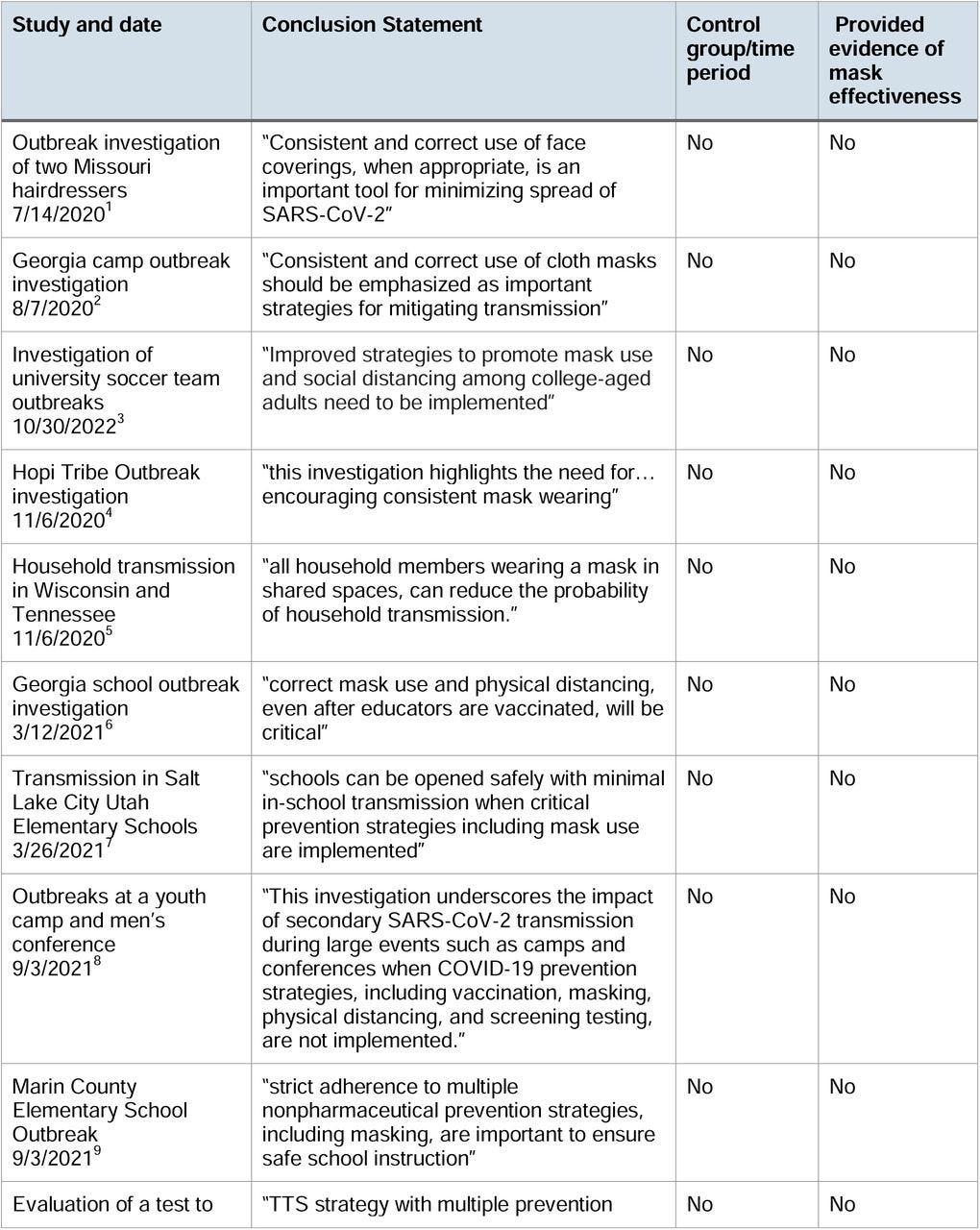
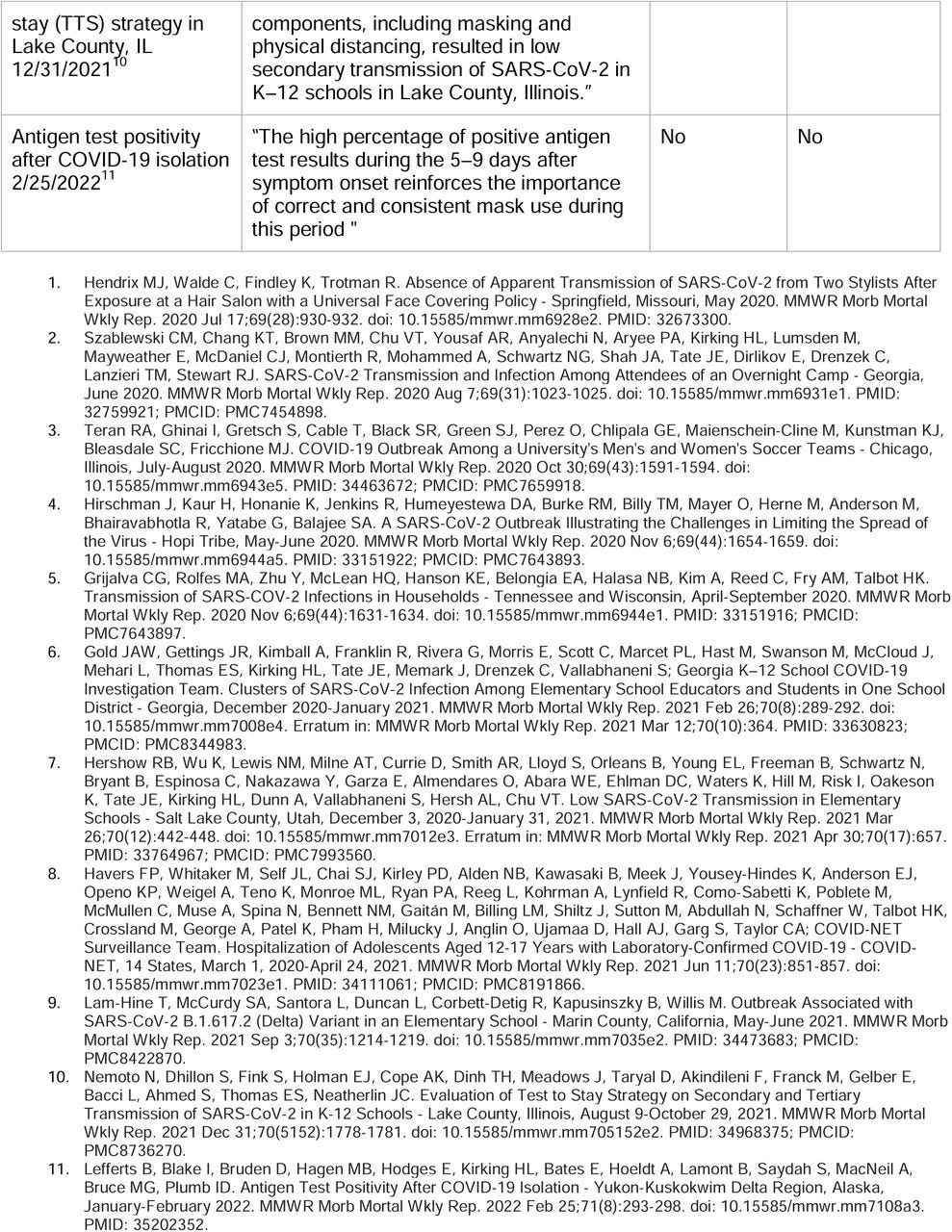
What makes this even more infuriating is that the CDC undoubtedly knew that their MMWR releases failed to prove that masks worked, yet were ensured that media outlets would blindly repeat their unsupported conclusions regardless.
Dishonest conclusions used dishonestly, to promote an unjustifiable policy goal.
Just one of all 77 studies included in the examination appropriately used casual language. Just one.
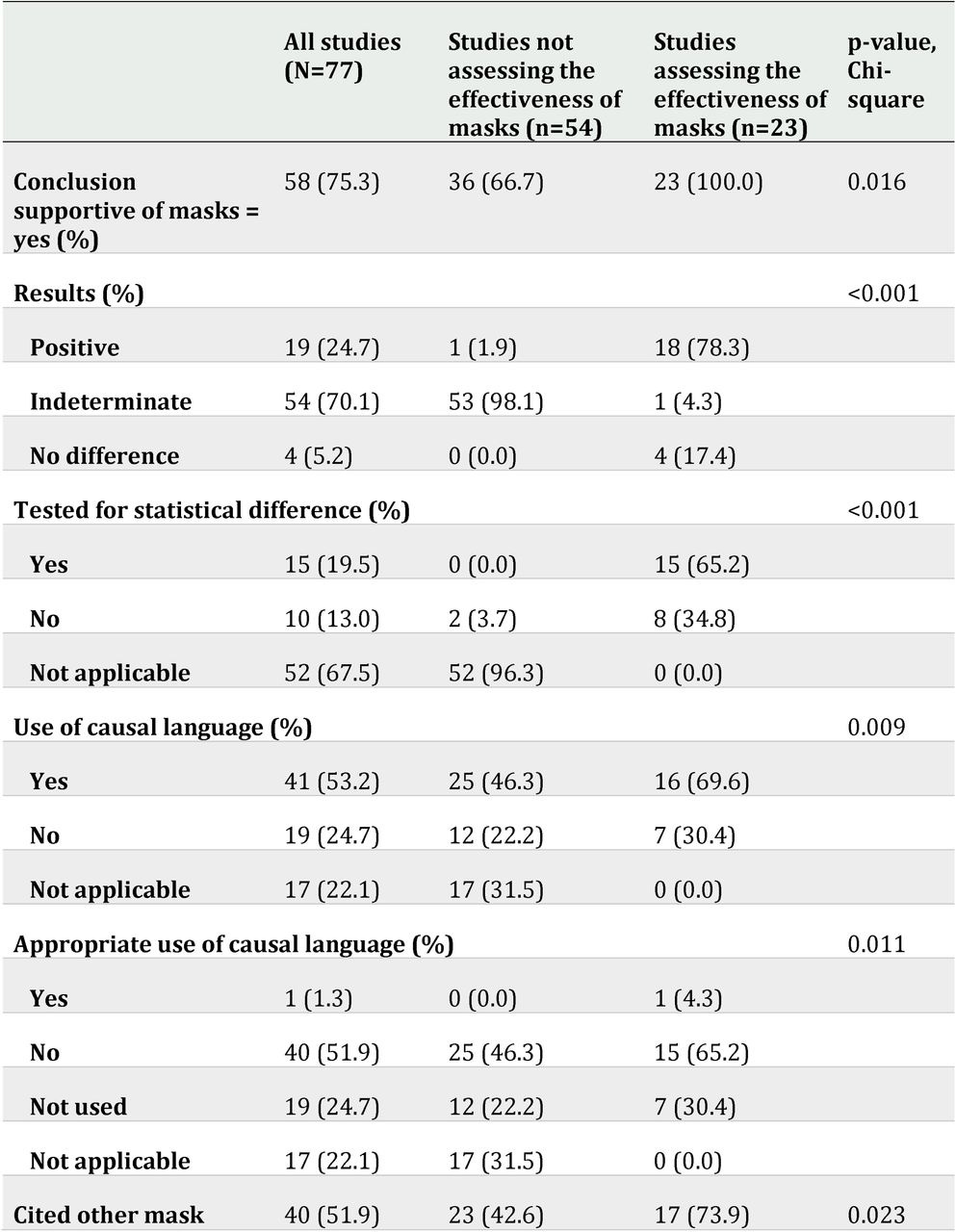
And that was a mannequin study.
“In another school masking study, errors in data analysis and methodology, which normally would warrant retraction, were not addressed by the journal.”
Høeg and Prasad also highlighted one of the CDC’s most inexcusable errors: promoting the unimaginably bad cloth masking study from California that used non-statistically significant results to misinform readers and the media that wearing masks would result in an 80% decrease in the risk of contracting COVID.
And in typically understated fashion, they explain that the consistently poor work displays pro-mask bias.
But their important work goes much deeper than being “suggestive of bias.”
It’s proof positive of the CDC’s disastrous ideology, their commitment to politics over evidence, and how corrupt the research process is in practice.
What should be the nation’s premier health agency had an agenda to promote masks, so they mobilized a group of researchers who rely on the CDC for funding and support to conduct desperate, low quality studies to justify their ideological needs. And the researchers were happy to comply.
The CDC then created easily digestible graphics meant to be laundered through an ideologically agreeable media that promoted unsupported conclusions.
Politicians relied on those graphics, Twitter “experts” shared studies, school administrators mandated masks - all based on low quality evidence they didn’t actually read.
And the CDC knew it, and encouraged it to continue.
The amount of harm, damage and permanent societal changes they introduced based on purposefully poor research is incalculable.
All while ignoring the importance of actual high quality research.
MMWR’s Used To Launder Misinformation To The Media
Much of the damage caused by the CDC was the result of the reliance of government figures and media outlets on their work.Politicians referenced the CDC while mandating masks, with former Nevada Governor Steve Sisolak specifically setting targets for mask usage based on the CDC’s research.
Legacy media outlets would purposefully and breathlessly report on their latest releases, regardless of how profoundly dishonest or misleading their messaging turned out to be.

The CDC's Latest Study on Masks is Purposeful Misinformation
An already discredited agency hits a new low
Vinay Prasad, Tracy Høeg and Alyson Haslam went to work dissecting just how bad the CDC’s research was, laundered through propaganda-esque MMWR releases.
And unsurprisingly, their conclusions showed just how politicized and unreliable the CDC was during the pandemic. Particularly on masking.
Objective: To describe and evaluate the nature and methodology of the reports and appropriateness of conclusions in MMWR pertaining to masks. Design, Setting and Participants: Retrospective cross-sectional study of MMWR publications pertaining to masks from 1978 to 2023. Main outcome measures: Study date, design, disease focus, setting, population and location. Whether the study was able to assess mask effectiveness, if results were statistically significant, if masks were concluded to be effective, if randomized evidence and/or conflicting data was mentioned or cited, if causal statements were made about effectiveness, and, if so, whether they were appropriate.
Seventy-seven studies met the criteria for inclusion. But in what perhaps is the clearest indicator of how hopelessly unusable mask research actually is, 0/77 were randomized trials.
Not one.
Instead, the CDC released 22 studies that contained no comparative group at all, and over 70% inappropriately used “causal language” despite having only 11 of the 77 studies claim statistically significant results.
Essentially, the CDC’s MMWR releases overstated their conclusions by using causal language to suggest that masks were effective, when the underlying methodology and results did not support that assessment.
The studies used by the media and politicians to justify their mandates and support were based on low quality evidence with unsupported conclusions.
MMWR publications pertaining to masks drew positive conclusions about mask effectiveness over 75% of the time despite only 30% testing masks and <15% having statistically significant results. No studies were randomized, yet over half drew causal conclusions. The level of evidence generated was low and the conclusions drawn were most often unsupported by the data.
There should be no doubt that the CDC purposefully promotes research that supports its conclusions, no matter how inaccurate. During their research, Prasad and Høeg found that 91% of the 77 MMWR releases were written by at least author associated with the CDC.
The CDC obtains research from authors associated with the organization then uses it to launder unsupported conclusions through a willing media.
No matter how much respect you’ve lost in the CDC over the past few years, it’s truly not enough.
But it gets worse.
Nearly 100% of studies did not reference conflicting data that would necessarily indicate the limited value of their conclusions.
75.3% inappropriately claimed masks were effective, despite the lack of supporting evidence.

And over 53% inappropriately claimed that their research established a causal link between masks and the claimed results.
The detailed summary provided shows how remarkably biased the conclusion statements were, relative to their actual provided evidence.


What makes this even more infuriating is that the CDC undoubtedly knew that their MMWR releases failed to prove that masks worked, yet were ensured that media outlets would blindly repeat their unsupported conclusions regardless.
Dishonest conclusions used dishonestly, to promote an unjustifiable policy goal.
Just one of all 77 studies included in the examination appropriately used casual language. Just one.

And that was a mannequin study.
“In another school masking study, errors in data analysis and methodology, which normally would warrant retraction, were not addressed by the journal.”
Høeg and Prasad also highlighted one of the CDC’s most inexcusable errors: promoting the unimaginably bad cloth masking study from California that used non-statistically significant results to misinform readers and the media that wearing masks would result in an 80% decrease in the risk of contracting COVID.
And in typically understated fashion, they explain that the consistently poor work displays pro-mask bias.
Taken together, the absence of randomized data, the lack of acknowledgment of conflicting or randomized data on mask efficacy, and the tendency to conclude masks are efficacious either without any, or sufficient, data to make causal claims, is suggestive of bias within the journal.
But their important work goes much deeper than being “suggestive of bias.”
It’s proof positive of the CDC’s disastrous ideology, their commitment to politics over evidence, and how corrupt the research process is in practice.
What should be the nation’s premier health agency had an agenda to promote masks, so they mobilized a group of researchers who rely on the CDC for funding and support to conduct desperate, low quality studies to justify their ideological needs. And the researchers were happy to comply.
The CDC then created easily digestible graphics meant to be laundered through an ideologically agreeable media that promoted unsupported conclusions.
Politicians relied on those graphics, Twitter “experts” shared studies, school administrators mandated masks - all based on low quality evidence they didn’t actually read.
And the CDC knew it, and encouraged it to continue.
The amount of harm, damage and permanent societal changes they introduced based on purposefully poor research is incalculable.
All while ignoring the importance of actual high quality research.
The World Health Organization (WHO) has warned that cases of dengue fever could reach record highs this year.
Dengue rates are rising globally, with reported cases since 2000 up eight-fold to 4.2 million in 2022, a WHO official said on July 21.
In January, the WHO claimed that dengue is the world’s fastest-spreading tropical disease and alleged it could be a “pandemic threat.”
The disease was found in Sudan’s capital Khartoum for the first time on record, according to a health ministry report in March, while Europe has reported a surge in cases and Peru declared a state of emergency in most regions.
About half of the world’s population is now at risk, Raman Velayudhan, a specialist at the WHO’s control of neglected tropical diseases department, told journalists in Geneva on Friday.
Cases reported to the WHO hit an all-time high in 2019 with 5.2 million cases in 129 countries, said Mr. Velayudhan via video link.
This year the world is on track for “4 million plus” cases, depending mostly on the Asian monsoon season. Already, close to 3 million cases have been reported in the Americas, he said, adding there was concern about the southern spread to Bolivia, Paraguay, and Peru.
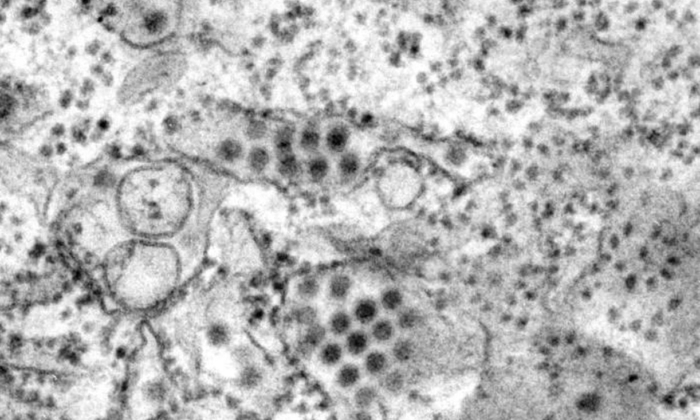
 www.theepochtimes.com
www.theepochtimes.com
Dengue rates are rising globally, with reported cases since 2000 up eight-fold to 4.2 million in 2022, a WHO official said on July 21.
In January, the WHO claimed that dengue is the world’s fastest-spreading tropical disease and alleged it could be a “pandemic threat.”
The disease was found in Sudan’s capital Khartoum for the first time on record, according to a health ministry report in March, while Europe has reported a surge in cases and Peru declared a state of emergency in most regions.
About half of the world’s population is now at risk, Raman Velayudhan, a specialist at the WHO’s control of neglected tropical diseases department, told journalists in Geneva on Friday.
Cases reported to the WHO hit an all-time high in 2019 with 5.2 million cases in 129 countries, said Mr. Velayudhan via video link.
This year the world is on track for “4 million plus” cases, depending mostly on the Asian monsoon season. Already, close to 3 million cases have been reported in the Americas, he said, adding there was concern about the southern spread to Bolivia, Paraguay, and Peru.

Cases of Severe Tropical Disease Exploding With No End in Sight: WHO
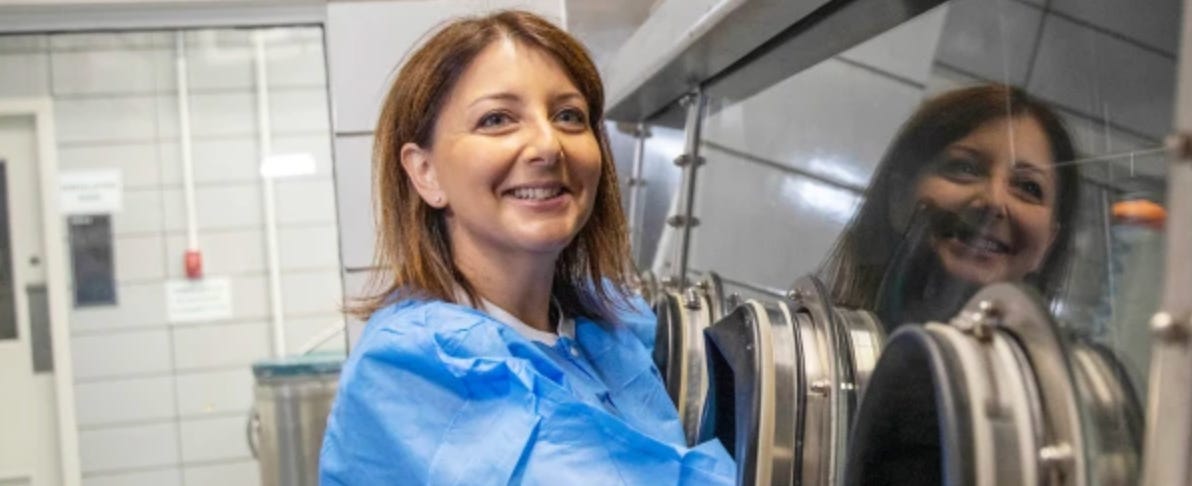
New CDC Director Mandy Cohen caught with her hand in the mRNA incubator
Restore trust? Uh huh, sure.
In one sense, you can’t blame the CDC’s perky new director, Mandy Cohen, she’s making a fortune, having hit the big time from her previous position in North Carolina where she oversaw that state’s lockdowns. But she’s facing some resistance: the article explained House Republicans want to cut the CDC’s budget, especially in areas related to climate change and gun control, which have nothing to do with germs.
Climate change and gun control are connected to the CDC via a fuzzy, generalized definition of “public health.” Try to follow Mandy’s logic: Public health falls under the CDC’s public health jurisdiction. Public health is a matter of national security. Everything is public health. Therefore, everything is a matter of national security and under CDC jurisdiction.
That’s why Mandy, who replaced the odious Rochelle Walensky, would like to militarize the CDC, for safety. “Just like we have a military to protect us here and around the world, we need a CDC that can protect us,” Cohen explained. "We can’t see those cuts and have the national security assets we need here at the CDC,” she said.
The article focuses on selling two competing ideas. First, the CDC is carefully, deliberately, and cautiously evaluating whether to recommend annual covid shots along with annual flu shots. They are not going to approve them unless it’s absolutely necessary, and unless they confirm the shots are absolutely 100% safe and effective.
You believe that, right?
No. We all know that soon there will be two shots on the annual adult vaccine schedule. Then three — don’t forget RSV! — then four, then five, then seventy-two. Every Tom, Dick, and Harry in America needs an HPV shot because tomorrow he might decide to become Loretta. He wouldn’t want to get cancer in his cervix. You think I’m making that up? From the Mayo Clinic website:

To be honest, my biggest complaint with the paragraph above is that Mayo used the pronouns “he or she” referring to doctors, which ignorantly erased all the other genders. I bet Hitler would have used the pronouns “he or she” too. Mayo should have said: “whether they recommend.”
Anyway, the article’s second pitch was “restoring trust in the CDC,” an oxymoron, and which supposedly is Mandy’s main concern. But in spite of abundant hand-wringing over lost trust, the article schizophrenically downplayed the problem. It reported that a paltry 25% of Americans reported they have “little-to-no trust in the CDC for health information,” and a tiny (but convicted) core of 10% who told researchers they do not trust the agency at all.
Count me among the 10%. I would trust Generalissimo Idi Amin with my healthcare before I’d trust the CDC.
Anyway, I suspect the “untrusting” numbers are actually much bigger than the article lets on, a fact confirmed by loss of trust in the agency being Mandy’s top concern. So I say “no” to both. No, I don’t want any more annual shots. I don’t care whether they are subsidized by the government. And no, I don’t trust the CDC.
Defund the CDC!

☕️ MANMADE ☙ Saturday, July 29, 2023 ☙ C&C NEWS 🦠
Corporate media prefers certain types of manmade disaster over others; Greek wildfire arsonists; NATO blamed for Ukraine's failing war; secret Chinese bioweapons lab pops up in California; more.
The FDA Relied On Wildly Overestimated Booster Efficacy Estimates To Make Decisions, As CDC Turns To Annual Shots
Høeg and Prasad were joined by Ram Duriseti, an M.D. from Stanford University, to examine a published study from December 2021 that claimed a monumental mortality benefit to those receiving booster doses.
Studies like the 2021 examination were frequently used by experts, politicians and administrators to justify booster mandates, since they seemed to indicate that additional doses were inarguably more protective and even more effective at “saving lives.”
Except as with so much of COVID research, the ends justified the inaccurate means.
First it’s important to understand the claims that were made based on the initial research. And they are dramatic.
Essentially, the study from “Arbel et al.” claimed that among those who’d received a Pfizer booster dose, there was a 90% lower rate of mortality due to COVID.
Using observational methods, Arbel et al. (Dec. 23, 2021, issue)1 calculated an adjusted 90% lower mortality due to Covid-19 among participants who received a first BNT162b2 vaccine (Pfizer–BioNTech) booster than among those who did not receive a booster. They found 65 Covid-19–associated deaths (reported as 0.16 per 100,000 persons per day) among participants in the booster group and 137 (reported as 2.98 per 100,000 persons per day) among those in the nonbooster group — a 94.6% difference. In a subsequent letter (March 10, 2022, issue),2 Arbel et al. reported 441 deaths not related to Covid-19 in the booster group and 963 deaths not related to Covid-19 in the nonbooster group.
Essentially, these results implied that the initial claims of 90+% efficacy from the two dose vaccination series could be re-established by getting a booster dose. Never mind the fact that waning efficacy, especially against new variants, was a problem that these researchers chose to ignore.
https://ianmsc.substack.com/p/the-cdc-repeatedly-and-purposefully
The calculations underlying these optimistic 90% estimates were used to indicate a “markedly lower incidence of adverse health outcomes in the booster group.” And a closer reading of the data shows where the problems with this influential study lie.
The mortality not related to Covid-19 was calculated as (441/65)×0.16=1.09 per 100,000 persons per day in the booster group as compared with (963/137)×2.98=20.95 per 100,000 persons per day in the nonbooster group. This corresponds to a 94.8% lower mortality not related to Covid-19 among participants in the booster group and indicates a markedly lower incidence of adverse health outcomes in the booster group.
The key is hidden in the first sentence.
The mortality not related to Covid-19 was calculated as (441/65)×0.16=1.09 per 100,000 persons per day in the booster group as compared with (963/137)×2.98=20.95 per 100,000 persons per day in the nonbooster group.
The differences in non-COVID related mortality between the two groups was astronomical.
What does that mean exactly? Well if the people who received the booster had a 95% lower non-COVID mortality rate, it implies that they were significantly healthier than the group that didn’t receive the booster dose.
And therein lies the problem with attempting to calculate vaccine efficacy by observing two different groups. They might have significantly variable underlying, pre-existing health conditions.
Healthier people, in the initial examination, chose to get boosted. Therefore, they were less likely to die.
But if you’re attempting to show a benefit against COVID-related outcomes, you have to adjust for such vast health disparities. The initial authors didn’t.
Høeg, Prasad and Durati reference this exact problem, defined as a “healthy vaccinee bias.”
The unadjusted differences in mortality related to Covid-19 and mortality not related to Covid-19, according to vaccination status, were essentially the same in the 2021 study by Arbel and colleagues. These findings arouse strong concern regarding unadjusted confounding. The adjusted 90% lower mortality due to Covid-19 reported among the participants who received a booster cannot, with certainty, be attributed to boosting. “Healthy vaccinee bias” in this population may have also led to overestimates of vaccine effectiveness in similar studies from Clalit Health Services.
The results claimed by the initial authors, the results relied upon by the FDA to justify their booster campaign, were likely based on biased methodology that stacked the deck in favor of vaccine efficacy. As they explain in the above passage, the adjusted mortality benefits due to vaccination “cannot, with certainty, be attributed to boosting.”
Because those that were boosted were less likely to die, regardless of whatever actions they did to protect themselves against COVID.

On Wednesday, WEF darling and Singaporean presidential candidate Tharman Shanmugaratnam, if that’s his real name, gave a joint press conference with WHO director-general Tedros Ghebreyesus, beginning with the outrageous fib that the World Health Organization is “dangerously underfunded.”
Don’t make me laugh.
After issuing a typical globalist demand for a plenary, collectivist “health” authority that can override individual nations’ sovereignty, for “safety,” Shanmugaratnam moved glibly into another area he knows nothing about, vaccines.
Ominously, Singapore’s likely next president and top WHO official first noted the “uptick” in covid numbers, and then revealed a very disturbing fact: the WHO and the IMF have brewed-up a brand-new vaccine action plan. "The first and most urgent priority is to implement the action plan set out by the WHO, IMF and their multilateral partners to vaccinate at least 60 per cent of every country’s population over the next year,” Shanmugaratnam gushed.
Sixty percent. Of the entire world. For covid. I am not making that up.
According to Channel News, Shanmugaratnam explained that the world is “vulnerable” to both a “prolonged COVID-19 pandemic,” with repeated waves affecting all countries, as well as future pandemics. "We can fix this," he whispered darkly, like a cartoon super-villain preparing to unleash an army of laser-equipped Mako sharks.
Repeated waves? Sounds a lot like influenza. Shanma-whatever didn’t explain how the useless vaccines that don’t stop transmission are supposed to prevent a “prolonged pandemic” with “repeated waves” in the first place. Maybe they should first start with something easier, like beating the common cold.
So anyway, it looks they are gearing up for another big jab push. I say good luck to them, they’ll need it. Unlike last time, we’re ready for them now.
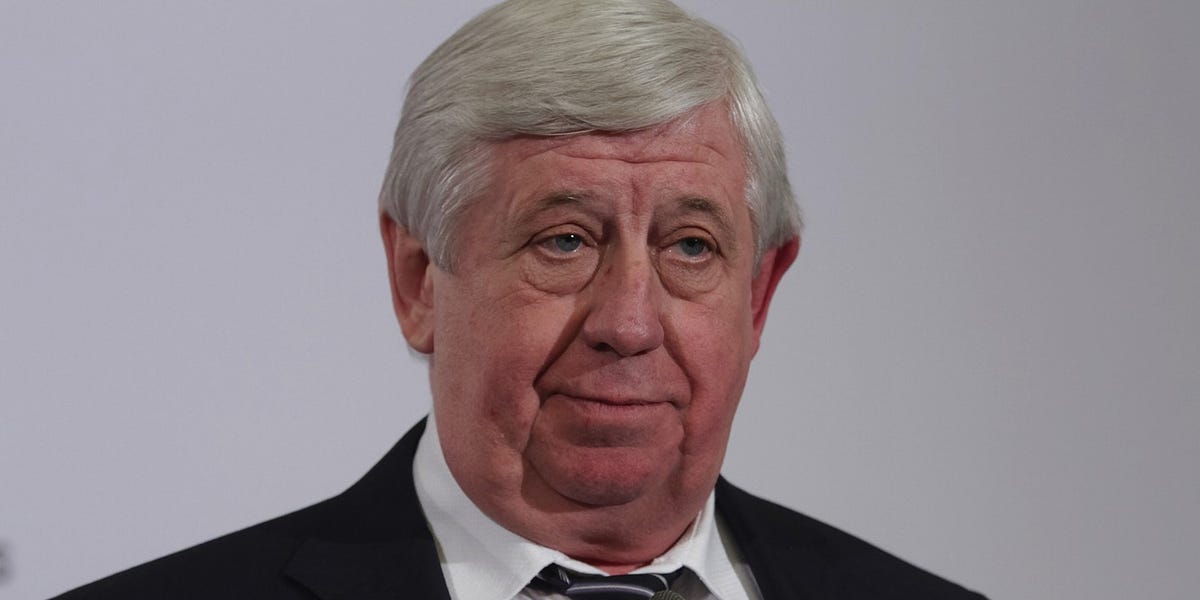
☕️ QUID PRO JOE ☙ Saturday, August 26, 2023 ☙ C&C NEWS 🦠
Fired Shokin to talk on Fox; Atlantic whiffs on mug shot; pedo relatives sue Kyle Rittenhouse; costs of the Proxy War; WHO/IMF vaccine plot; great disinformation story; variable sentencing; more.
CDC Removes COVID Vaccine Adverse Event Reports From Website: Report
Dr. David Gortler, a Brownstone Institute Fellow who formerly served as a senior official and advisor for the FDA, first reported the change in the CDC’s website, questioning why the federal agency removed the data.
“Does this mean that the CDC believes that the mRNA Covid-19 injections are so safe, there is no need to monitor adverse event reports any longer?” he wrote. “What is the argument against continued monitoring, especially since the V-safe website was already up and paid for?”
Since mRNA injections hit the market in 2021, Gortler cited the FDA’s VAERS database that allegedly names the vaccines as the number one cause of more than 1.5 million adverse event reports, including heart attacks and cases of myocarditis and pericarditis in the U.S.

